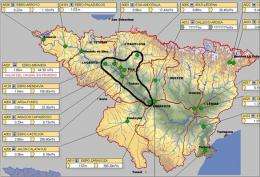Simple method devised to predict rises in Ebro River level

A team of researchers from the University of Castilla-La Mancha (UCLM) has developed a new mathematical method to easily predict rises in the level of the Ebro River in Zaragoza based on water flow recorded in Castejón (Navarre). The system has a 97.5% success rate for 20-hour predictions.
“The objective of this work is to prevent flooding in Zaragoza, giving sufficient advance warning to minimise damage and improve the management of the river,” Diego J. Pedregal, a co-author of the study and a professor at the UCLM’s Higher Technical School of Industrial Engineering, tells SINC.
The study, to be published in April in the journal Environmental Modelling & Software, looks at the problem of how to model and predict the flow and levels of the Ebro in the regional capital of Aragon, based on analysis of a 110km section that starts in the town of Castejón, in Navarre.
Pedregal tells SINC that there are other predictive models, “but these are much more complex, determinist, and include a wide range of variables”, while the new model developed, while being less technically conventional, “is more flexible, and is so easy to use that it can be done on any PC”.
The researchers developed the predictive system in two stages. First of all they used a mathematical “transfer” function to determine the scale of the
model and get an approximate idea of the time delay before the water flowing through Castejón has an impact on water levels in Zaragoza.
“But the river’s dynamics don’t behave in a linear way,” points out Pedregal. The professor explains, for example, that the water flows more quickly when it is at an average or low level, that storms do not have the same effect on a dry river bed (which absorbs more water) as a wet one, and that rapid thawing of snow introduces slushy water into the river, which behaves in a different way than liquid water.
All these factors, along with the physics of fluid itself, means that the dynamics of rivers are “not linear”, resulting in the researchers having had to use mathematical systems to reflect these factors and produce a specific algorithm to incorporate the impact of all these variables.
The predictive ability of the model has been contrasted with information from the historical database of the Hydrographic Confederation of the Ebro River, resulting in an average error rate of 2.5% over a 20-hour prediction timescale.
More information: D.J. Pedregal, R. Rivas, V. Feliu, L. Sánchez y A. Linares. “A non-linear forecasting system for the Ebro River at Zaragoza, Spain”. Environmental Modelling & Software 24 (4): 502-509, abril de 2009.
Provided by Plataforma SINC












